When I’m working with a small embroidery design – for example, a small sample element like the interlocking knot in the plaited braid stitch sample I showed you yesterday – to transfer the design to fabric, I use a very simple method that many of you may already know. I think it’s worth mentioning, though, in case you don’t know it, because it’s definitely a time saver and very convenient.
I call it soft lead tracing, but I’m sure there is some technically correct term out there besides this. The idea is the same as carbon paper, without the carbon paper. When you can’t readily trace your design, either because you can’t see well enough through the fabric or you don’t have a sunny window or light box available, this method is a quick life-saver with certain types of designs and certain types of fabric. In fact, I generally prefer it to regular tracing with small motifs, because I think it’s more accurate, and it’s a lot faster and more convenient than hauling out the light box or taping my pattern to a windowpane.
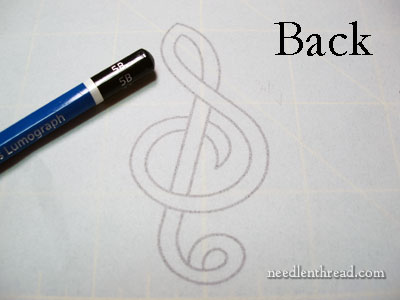
The conditions under which this design transfer method works best are: 1. that you’re working with a small, clear design (nothing too complex that will take a while to draw); and 2. that the fabric you’re using is relatively light colored and has a smooth hand (i.e. higher count lines, cotton, etc., that aren’t “bumpy”).
I always print or draw my final designs on drafting & design vellum, which is a smooth, somewhat transparent paper, but this method works with any type of paper, really, as long as the paper will hold up to a good working over with a semi-sharp tipped pencil or pen.
Start on the back of the design paper. Using a soft pencil (I’m using a 5B here – you can find various types of pencils in the drawing section at any art store), trace over the design on the back of the paper.
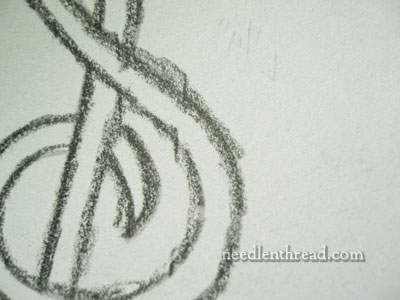
No need to be too incredibly neat here – just a good coating of the soft graphite following the design line works.
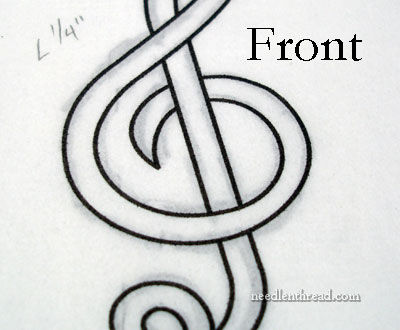
Turn your paper over so that the front is up, and situate it on your fabric, wherever you want your design. Then use a regular pencil (I used a mechanical pencil) or a pen with a hard tip (like a ball point) and trace over the design lines on the front of the paper, pressing firmly.
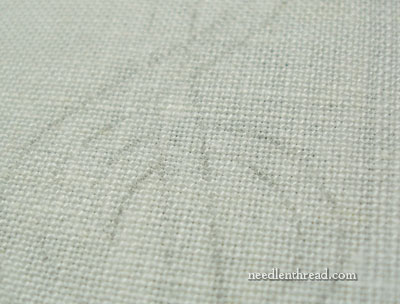
When you remove the paper, you’ll end up with a clear enough line to see the design fairly well, but…
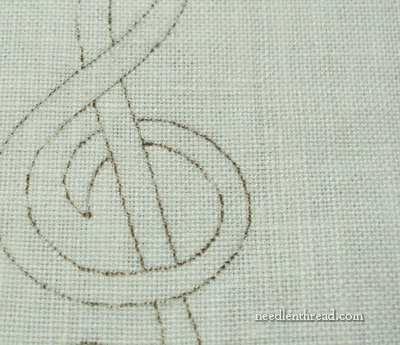
… you can always darken the line further by drawing over the graphite transfer line with a fine tipped art pen (I use Sakura micron pens).
This is a fast, easy, accurate way to transfer a simple design to fabric. Next time you’re in a design-transfer bind, give it a try! (As always, with any new-to-you transfer method, you should practice it first on a scrap of fabric.)
If you’re curious about other methods, you can find an extensive list of other embroidery design transfer methods here on Needle ‘n Thread.







G’day there Mary,
Sweet.
Thank you. Cheers, Kath
Thanks Mary thats so interesting am going to give it a try. We learn something new every day!
love Trish
Dear Mary
I love your ideas, what an easy way to transfer a small design, I will certainly try this method next time I need to transfer a small design. Is vellum paper similar to tracing paper? Thanks for sharing this with us.
Regards Anita Simmance
Thank you Mary,
I am definitely going to give it a try.
Have a good day
Alet out of Libya
I had never heard of this method before Mary. I can see it’s advantages for certain projescts. Thank you so much. You are a wealth of knowledge.
Mary,
I’ve been using this method for transferring liturgical designs on linen for years. I don’t know what to call it either, but it sure works well on most of the designs that I’ve had to do.
I’ve used this once, and I have to admit I really like it. It’s easy and fairly accurate. Thanks for the reminder!
That’s actually called a graphite transfer (so soft lead transfer wasn’t too far off!). I did that a lot in college as a graphic design student. You can even buy graphite sticks (they look like pastels if pastels were made of pencil lead) at most craft stores that let you cover more space quicker. Dick Blick has them in 2B, 4B and 6B for 60 cents each. http://www.dickblick.com/products/generals-wide-compressed-graphite-sticks/?clickTracking=true
Thank you Mary. An invaluable tip.
Could you or any of your other readers suggest an alternative to the Sakura micro pen? I can’t seem to find that where I live.
Have you ever drawn or seen any embroidery patterns for monograms of Greek letters?
I am a beginner and I am learning embroidery through your website. I first embroidered a handkerchief for my mother and showed to my Colleagues. One of my Colleague Mrs. Rukmani gave me a Turkey Towel Cloth and asked me to try in that cloth. I was not able to transfer the pattern in that cloth through Carbon Paper or through Lead pencil. Then I traced the pattern to the tracing sheet and pinned in the Turkey Towel and embroidered the backstitch as an outline.
I want to know after finishing the work how to remove the tracing paper from the cloth.
I have found several designs I want to embroider on this article. I need to have tracing paper in enough to see through so that I can trace the design from my phone screen to the paper and then transfer the design to the fabric. I have been looking at embroidery transfer paper and stabilizer on Amazon and I have put in soluble tracing paper but I can’t seem be able to find out if any of the transfer paper or stabilizer is thin enough to see to trace my design onto the paper and then onto the fabric.